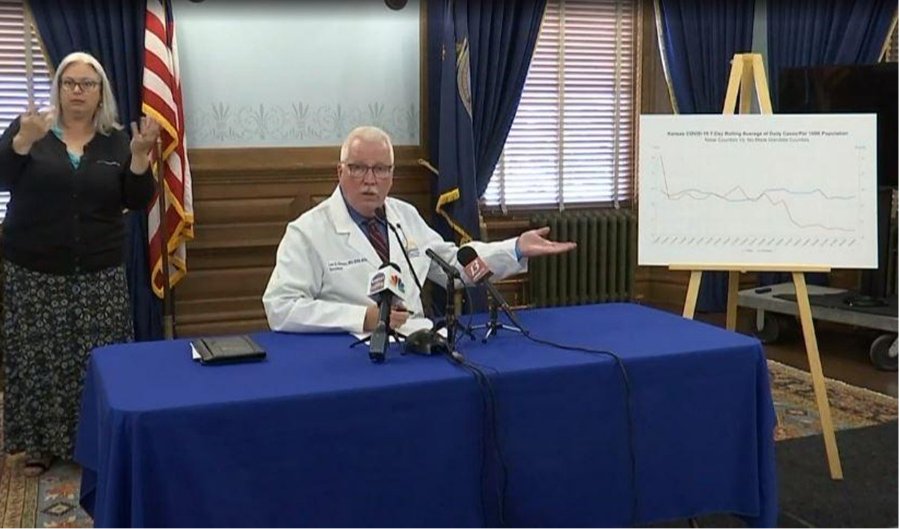This summer, a relative reached out to me regarding the sad story of Kodie Dutcher, a 10-year-old from Baraboo, Wisconsin who was reported missing in July.
Law enforcement officials put out an Amber Alert, and a volunteer search party was organized. Kodie’s body was found the following morning—July 7, a Tuesday—near her home. Her death was ruled a suicide by the Baraboo Police Department.
Kodie’s death shook me. I grew up in a small town not far from Baraboo and know people who live there today. It occurred to me that my own little girl, whom I still think of as a baby, is roughly the same age Kodie was when she took her life.
The COVID-19 pandemic has been a challenge for everyone, but evidence suggests that few demographics are suffering more than young people. Data show they’re suffering more economically, and emerging evidence shows that many are less equipped to deal with the “collateral damage” of forced lockdowns mentally.
A new report from the Wisconsin State Journal examining mental health trends in Dane County, the second most populous county in Wisconsin, shows that many are struggling to cope with the mental toll of social isolation precipitated by the economic lockdowns.
Hannah Flanagan, the Director of Emergency Services at Journey Mental Health Center, said calls to the center’s crisis hotline are up more than 15 percent since the beginning of the pandemic, with many people suffering not from severe mental illness but situational stress. Preliminary data collected by the center show that Dane County passed its 2019 suicide count in early October.
Flanagan said Dane County had experienced 57 suicides as of early October, more than the total of 54 it had experienced the entire calendar year in 2019. She indicated that the excess deaths largely stem from stay-at-home orders.
“When people are lonely, it’s really hard to cope,” Flanagan said. “The specificity about COVID social distancing and isolation that we’ve come across as contributing factors to the suicides are really new to us this year.”
It’s alarming to see a large county eclipse its previous suicide total with nearly three months remaining in the calendar year, but the numbers become even more troubling when you drill into them a little further. The center’s figures show that 15 of these suicides were committed by people under the age of 25. That’s nearly double the total in 2019 (eight)—and we still have nearly three months until the year is over.
One could dismiss these figures as anecdotal evidence or a strange outlier. The problem is it fits with other mental health trends around the country. The CDC recently reported that one out of four young people have contemplated suicide during the pandemic, about two and a half times the overall rate.
Though national data on youth suicide during the pandemic is not yet available, trends reported from suicide hotline centers across the country show that many young people are crying out for help.
Social Isolation Is Deadly
Flanagan’s explanation that the spike in suicide in Dane County is tied to COVID-19 lockdowns dovetails with years of science that shows social isolation isn’t just psychologically harmful to humans, but deadly.
An abundance of scientific evidence shows social isolation “is one of the main risk factors associated with suicidal outcomes.” The dangers are particularly acute in women, research suggests.
This is why from the beginning of the pandemic there has been a small but consistent chorus of researchers warning that forced isolation could prove to be “a perfect storm” for suicide.
“Secondary consequences of social distancing may increase the risk of suicide,” researchers wrote in an April 10 paper published by the American Medical Association. “It is important to consider changes in a variety of economic, psycho-social, and health-associated risk factors.”
It should be noted that suicide is just one of the deadly effects of social isolation. Dr. Dhruv Khullar, a physician and assistant professor of healthcare policy at Weill Cornell Medical College, detailed numerous other deadly effects of social isolation in a popular 2016 article in the New York Times:
“A wave of new research suggests social separation is bad for us. Individuals with less social connection have disrupted sleep patterns, altered immune systems, more inflammation and higher levels of stress hormones. One recent study found that isolation increases the risk of heart disease by 29 percent and stroke by 32 percent.
Another analysis that pooled data from 70 studies and 3.4 million people found that socially isolated individuals had a 30 percent higher risk of dying in the next seven years, and that this effect was largest in middle age.
Loneliness can accelerate cognitive decline in older adults, and isolated individuals are twice as likely to die prematurely as those with more robust social interactions. These effects start early: Socially isolated children have significantly poorer health 20 years later, even after controlling for other factors. All told, loneliness is as important a risk factor for early death as obesity and smoking.”
Tradeoffs: An Economic Reality
Unfortunately, nations around the world and many US states have failed to assess these risks. Policymakers, perhaps incentivized by a 24-hour media that tracked and reported COVID-19 deaths like a sporting event, have adopted empty slogans such as “if it saves just one life.”
It rarely occurs to lawmakers to also look at the lives lost as a result of their policies.
“There are no solutions, there are only trade-offs,” the famous economist Thomas Sowell once observed, “and you try to get the best trade-off you can get, that’s all you can hope for.”
Tradeoffs are a simple economic reality, but one humans often overlook. The idea was perhaps best described by economist Russ Roberts, who noted that every choice also means giving something up.
In many ways, the pandemic is a perfect example of ignoring the reality of tradeoffs. Lawmakers saw that by enforcing social distancing, they were (in theory) limiting the spread of the virus. What they didn’t see was the tradeoffs: lost social interaction that is crucial for humans, cancer screenings abandoned, jobs lost, AA meetings canceled, babies denied heart surgery, and so on.
As economist Antony Davies and political scientist James Harrigan noted early in the pandemic, across the country we saw the leaders of America’s institutions—county councils to mayors to school boards to police to clergy—simply ignore the realities of tradeoffs:
“Rational people understand this isn’t how the world works. Regardless of whether we acknowledge them, tradeoffs exist. And acknowledging tradeoffs is an important part of constructing sound policy. Unfortunately, even mentioning tradeoffs in a time of crisis brings the accusation that only heartless beasts would balance human lives against dollars. But each one of us balances human lives against dollars, and any number of other things, every day.”
Americans, particularly those with influence and those in leadership positions, should recognize that lockdowns—and indeed all sweeping government-mandates—come with a host of unintended consequences.
The failure to acknowledge or adequately consider them is why so many people today are in pain—and why more young Americans are seeking to throw away their most precious gift.
Jon Miltimore
Jonathan Miltimore is the Managing Editor of FEE.org. His writing/reporting has been the subject of articles in TIME magazine, The Wall Street Journal, CNN, Forbes, Fox News, and the Star Tribune.
Bylines: Newsweek, The Washington Times, MSN.com, The Washington Examiner, The Daily Caller, The Federalist, the Epoch Times.
This article was originally published on FEE.org. Read the original article.



